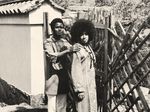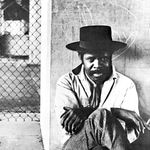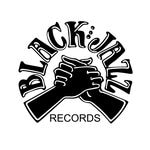
Doug Carn, left, with his wife, Jean Carn, in a detail from the cover of their album <em>Spirit of the New Land</em>, released on Black Jazz Records in 1972.
Courtesy of Real Gone Records
The dawn of the ’70s were heady times for keyboardist Doug Carn and drummer Michael Carvin. Both men had recently relocated to Los Angeles from points south; Carn came from Florida, Carvin from Houston. Carn was getting gigs with well-known bands like Nat Adderly and Earth, Wind And Fire, while Carvin was getting work in television bands as a sideman. Most central to the pair, though, was the demo the two had recorded along with Carn’s wife, vocalist Jean Carn, that they thought marked the future of jazz. Inspired by three legendary African-Americans – Dr. Martin Luther King, John Coltrane and Muhammad Ali – Carn had written lyrics for music composed by Coltrane, McCoy Tyner and Wayne Shorter, which were then sung by Jean, who imbued the songs with an energetic vibrance. “I felt we were creating a new set of standards,” Doug Carn tells NPR Music.
Carn took the demo to some of the prominent jazz labels of the time, like Blue Note, Impulse! and Columbia, but, to his honest surprise, found no takers. Even in retrospect, it is a head-scratcher; the music’s spiritual overtones both echoed Coltrane, just a few years removed from his death and already a towering figure, and the work of one of Coltrane’s proteges, Pharoah Sanders, who notched a hit in 1969 with the song “The Creator Has a Master Plan,” from his 1969 recording Karma – a cornerstone of the spiritual jazz that Carn was creating. Plus, the sound of Carn’s ensemble had a pan-African feel in the rhythms, which echoed a trend in several jazz styles.

The cover photograph for Gene Russell's album <em>New Direction</em>, the first release on Black Jazz.
Courtesy of Real Gone Records
Still without a home for their recordings, Carn and Carvin then heard of a new label, Black Jazz Records, which was being run in Oakland by Gene Russell, a pianist who had scored a minor hit with the piano trio album Up And Away, which featured covers of contemporary pop tunes. Russell was planning to make his new label focus on artistic self-determination, rather than conformity to the marketplace. The cover art told the story of his transition: Russell’s Decca recording had featured its title in a bright, psychedelic color scheme, overlaid on a photo of Russell in the engine of an airplane, holding balloons. It’s presentation was whimsical; almost a rebuttal of the tumult in the streets. The first release on Black Jazz, his own album, aptly titled New Direction, featured a black-and-white photo with a black frame and white typeface. The logo featured a soul-brother handshake, and the photo of Russell was of him in a black hat and blue jeans, assertively looking at the camera, clearly an independent urban spirit. In style it was an endorsement of post Civil Rights life for African Americans; there was less need to please the dominant society.
Carn and Carvin were all-too-right about their hunch. Russell heard the demo and, rather than send them into the studio to record fuller versions of the music, simply released it as Infant Eyes, one of the first recordings on his new imprint.
Jazz has always been a celebration of Black self-determination, but the jazz recording industry often failed to reflect that priority. Russell and his co-founder, Dick Schory, were among several artists and businessmen eager to challenge the paradigm. They weren’t alone – the late ’60s and early ’70s witnessed a flowering of independent spirit in the jazz community. Collectives sprung up around the country — the Association of the Advancement of Creative Musicians in Chicago (AACM), the Black Artists Group in St. Louis, the Union of God’s Musicians and Artists Ascension in Los Angeles all among them — to present and nurture the creation of a new music.
Artist-run labels followed in the same spirit. Sun Ra had created El Saturn Records to release his own work. Betty Carter created Bet-Car for hers. Trumpeter Charles Tolliver and pianist Stanley Cowell formed Strata East as a home for their work and that of their peers. DJ and impresario Jimmy Gray and saxophonist James Branch launched Black Fire Records to document the burgeoning African-American music scene in Washington, D.C. All of these labels captured a moment when Black people — musicians and fans alike — were resisting the definitions that had been imposed on them by white society and creating different sounds of blackness. Black Jazz Records was one of the biggest and most ambitious among them.
Black Jazz was founded in Oakland, also home to the Black Panther Party, an enduring icon of the African-American struggle for self-determination. Russell and Schory ran it from that city until 1975, after having released 20 albums, and in the ensuing 45 years the music has gone in and out of print, admired by jazz-influenced hip-hop artists and DJs and crate diggers everywhere. In late summer, Real Gone Music, an imprint dedicated to reviving lost catalogues of albums, launched an eighteen-month program which will put the entirety of the Black Jazz Records portfolio back in print. The breadth of the work is exceptional; even from an era where musical boundaries blurred, the Black Records sound is unusually diverse. There is classic piano-trio music from Russell, innovative larger-group work by bands like The Awakening and stunning vocal albums by newcomers like Kellee Patterson. Aaron Cohen, author of Move On Up: Chicago Soul Music and Black Cultural Power, wrote of the era: “… it seems like there was a conscious effort to find artists who engaged with the manifold and diverse expressions of African-American music at the time, whether it was more popular leaning or more experimental. Indeed, Black Jazz showed that those impulses need not be mutually exclusive.”

The Black Jazz logo.
Courtesy of Real Gone Records
The range of recordings in the first batch of Black Jazz Records reissues show this clearly. Carn’s Spirit of the New Land has the distinctive style hallmarks of the Black Jazz catalog (Infant Eyes will release in spring 2021). An illustrious ensemble that included Tolliver on flugelhorn, Alphonse Mouzon (who later gained renown with Larry Coryell and Weather Report) on drums and Earl McIntyre, whose credits range from Stevie Wonder to Cecil Taylor, on tuba, all playing Carn originals as well as Miles Davis’s “Blue in Green” and Lee Morgan’s “Search for the New Land,” each with lyrics added by the keyboardist. He said it reflected that it was “a crucial time on Black struggle in America.”
The other recordings in the first set of reissues are a dynamic session led by pianist Walter Bishop, with trumpeter Woody Shaw, saxophonist Harold Vick and bassist Reggie Johnson, and a superb recording by the Chicago-based group The Awakening, a band which featured several musicians associated with the AACM there. That latter album begins and ends with recitations of poetry, and in-between features exceptional hard bop-inspired virtuosity. In late September, the label will release Maiden Voyage, the debut recording from Kellee Patterson, who was the first Black woman to compete in the Miss America Pageant.
By 1975, Russell was looking to branch out beyond jazz. He closed Black Jazz Records and launched a new imprint, Aquarican, but managed to release only one album through it (Chyenne’s Coming by Chyenne Flower, a jazz-rock group somewhat reminiscent of Tower of Power) before his death in 1981. Although Russell’s artists continued to thrive – most notably Jean Carn who, as Jean Carne, had a stellar career as an R&B singer – the music of Russell’s Black Jazz Records label has remained obscure, principally known only to aficionados like the DJ and producer Gilles Peterson.Gordon Anderson of Real Gone Music, a nine-year-old company that specializes in reviving vintage catalogs, took an interest in remedying that obscurity. He says that he was motivated in part by the prices Black Jazz Records were fetching from collectors, “here’s a label with only 20 records that [were all] very sought after.”
But, as the release dates for the first Black Jazz reissues approached, ownership disputes broke out, with several parties claiming rights to the music and Russell’s heirs wanting their share, too. As of this writing, there is no legal clarity around the matter; all of the parties are searching for documents to substantiate their contentions. Meanwhile, many of the musicians involved acknowledge that, while Russell presented the label as his, there was doubt that he had funded it himself.
The pending reissues triggered another strong reaction overseas, where concerts were held in advance of the 50th anniversary of the label. Last autumn, there were sold-out shows in Paris and Berlin (a London booking was postponed due to the pandemic). “It was amazing,” said Carvin. “Almost 50 years after the release of these records, places were sold out, standing-room-only-type crowds, to hear the music we were making back then.” He was also pleased to see that the crowds weren’t older people indulging nostalgia, but younger folks discovering the style, too.
In some ways, it’s not surprising. The Afro-Diasporic sound of Black Jazz can be found in numerous artists on today’s scene: Kamasi Washington, Nubya Garcia, Shabaka Hutchings and many more echo both the musical diversity and spiritual aspects of the Black Jazz aesthetic. Cohen agrees with the resonance, noting that artists like Angel Bat Dawid likely heard the music of The Awakening, and that the underlying philosophy from that era has spread far and wide.
“The jazz, R&B and spoken word hybrids from decades ago have clear connections to jazz, R&B and hip hop/spoken word today. The times that Black Jazz records have been sampled have also been a part of its legacy (I counted at least a dozen on whosampled.com),” Cohen writes in an email. Also, he notes the self-reliance aspect being crucial to music in the diminished state of the recording industry today, and he concluded, “issues of social consciousness that undoubtedly fueled the rise of such companies as Black Jazz have reverberated today through the Black Lives Matter movement.”
Copyright 2020 NPR. To see more, visit https://www.npr.org.